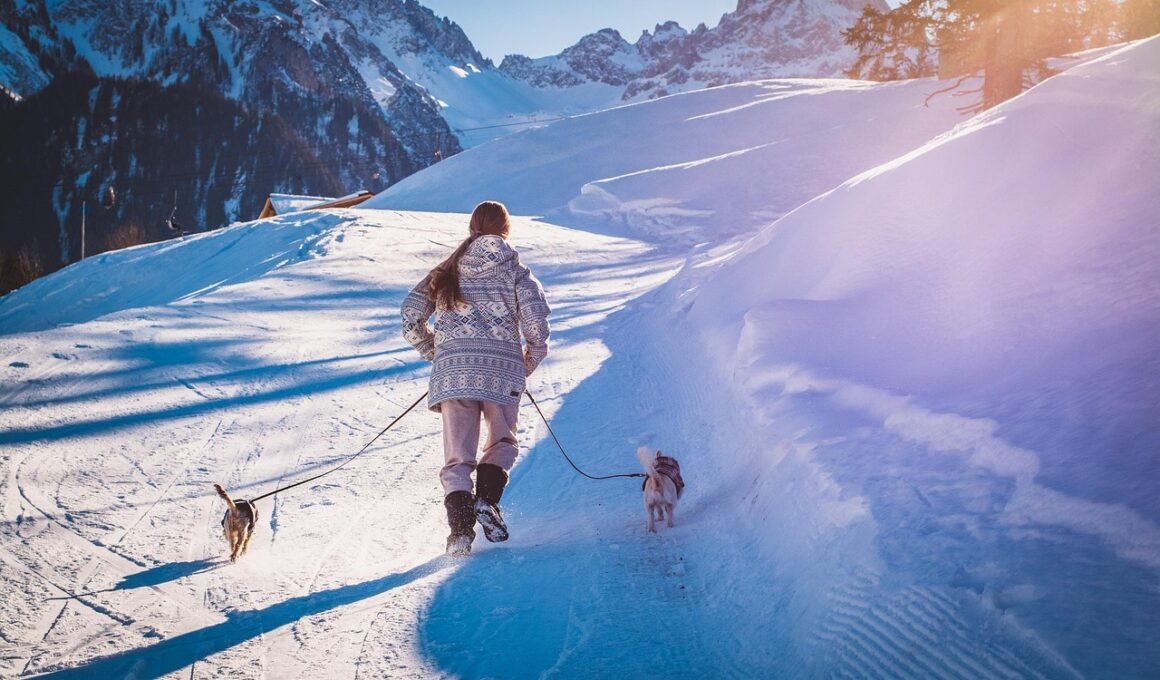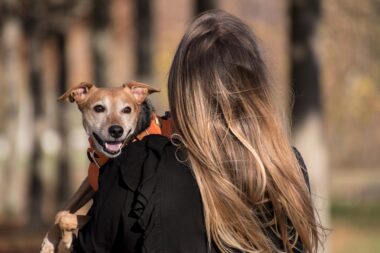How to Adjust Your Dog’s Exercise Time During Winter Months
As the winter months approach, dog owners often face challenges regarding their dog’s exercise routines. The colder temperatures can make it difficult to maintain regular exercise schedules. It is essential to adapt your dog’s exercise routine to suit the winter environment, ensuring your pup remains active and healthy. First, it’s crucial to analyze the local weather and choose times when it’s least harsh. Morning and early afternoon sessions tend to be warmer and more enjoyable for dogs and their owners. If your dog enjoys playing in the snow, consider incorporating fun activities like fetching snowballs or playing hide-and-seek. On particularly chilly days, shorter, more frequent exercise sessions may be beneficial, allowing your dog to get the physical activity they need without overexposing them to cold temperatures. Remember to check your dog’s paws after walks, as they can be susceptible to freezing or cracking in icy conditions. Additionally, dress your dog appropriately with sweaters or booties for added warmth and protection, ensuring they stay cozy while exercising outdoors. Keeping a close watch on your dog during winter will promote safety and enjoyment alike.
Changing your dog’s exercise schedule can help you and your furry friend adjust better to winter conditions. Aim to find times during the day that provide the best temperatures for outdoor activities. Early mornings or late afternoons tend to be warmer, yet still crisp enough to enjoy. For those who can’t fit in exercise during weekdays, consider scheduling longer weekend walks or playdates. This will ensure your dog receives adequate physical activity throughout the week. Rotating between different activities can also enrich your dog’s experience. Mixing in sessions like walking, running, or even engaging in dog sports keeps your pet mentally stimulated. If temperatures drop significantly, exploring indoor facilities such as doggy daycare or indoor dog parks can provide fantastic alternatives, ensuring they remain social and active. Moreover, using toys that encourage home play during bad weather ensures physical activity doesn’t take a backseat. Interactive toys help engage dogs, allowing play even when stuck indoors. Maintaining consistency in creating exercise opportunities will keep your dog happy and healthy throughout the winter months. Overall, finding suitable times and settings offer enriching experiences for both you and your dog during these cold days.
Another crucial consideration when adjusting your dog’s exercise time is the additional gear that can improve comfort and safety. Services and stores provide various options, including reflective vests, warming jackets, and insulated waterproof boots. These accessories enhance visibility and warmth during winter walks, keeping your dog protected from the elements. You might notice that pooches with shorter coats feel cold more quickly, so investing in a proper dog coat is a wise choice. Always ensure they fit properly to avoid any discomfort while your dog moves around. When it comes to paws, consider applying a protective balm, helping shield against freezing temperatures and harmful salts found on sidewalks. If your dog dislikes wearing boots, refrain from forcing them and explore various alternatives. Training your dog to comfortably wear accessories can greatly benefit them during intense weather conditions. Additionally, particularly cold days may require shortened walks, so focus on high-energy activities that can tire your pup out effectively. Never hesitate to adjust sessions based on your dog’s comfort levels during each walk as necessary. Keeping their spirits high with fun options can improve their overall enjoyment and health during winter.
Signs Your Dog is Cold
As responsible dog owners, it’s vital to recognize signs that indicate your dog is feeling cold when exercising outdoors. If you notice your pet shivering, whining, or attempting to burrow against you, these can be clear indicators that they need a break and some warmth. Other signs may include lifting paws off the ground, reluctance to walk or run, or a sudden change in behavior. It’s crucial to stop the exercise immediately and assess whether they need to head inside or put on an extra layer of warmth. Paying attention to your dog’s body language during these outings can prevent potential injuries related to cold weather. When your dog shows any of these signs, it’s essential to take action quickly to ensure their safety and comfort. If conditions worsen, consider carrying your pet for a brief walk or restricting playtime to brief intervals. Always have a safe shelter available nearby for warming up. Understanding and acting appropriately based on these signs will help keep your pets healthy and enjoying their winter experiences.
When transitioning to new exercise schedules, incorporating mental stimulation alongside physical activity becomes crucial. Various activities can entice your dog’s brain and provide valuable mental challenges. For instance, engaging in obedience training or learning new tricks sharpens their minds and creates stronger bonds between you both. Alternatively, exploring puzzle toys can engage your dog’s mind during downtime, providing stimulation even inside the home. Additionally, it’s beneficial to designate specific indoor play areas to facilitate engaging tasks while allowing social interactions with other animals. If possible, rotating different toys helps maintain interest and excitement in your dog’s daily routine. Always remember that a mix of physical and mental exercises promotes overall well-being, especially during cold winter months when outdoor time may be restricted. Plan shorter and varied indoor sessions each week to keep your dog’s energy levels balanced effectively. By integrating these activities into your routine, you can nurture a happier dog, resulting in a more content winter experience for both of you. Overall, keeping your dog’s mental agility sharp and body active is essential even when faced with harsh winter conditions.
As winter arrives, considering your own exercise routine can help in making adjustments for your dog as well. Many owners allow cold weather to disrupt their physical activity, resulting in less time dedicated to their pets. It’s essential to maintain your fitness to set a strong example for your pup. Consider making outdoor activities enjoyable by bundling up and embracing the colder environment. Not only will this keep you and your dog active, but it can also strengthen your bond through shared experiences. If you find yourself hesitant to embrace winter, explore alternate indoor exercises, such as yoga, which you can efficiently do with your dog around safety measures in mind. Building a routine strengthens commitment to both your fitness goals and your dog’s needs during colder months. Additionally, committing to these shared moments can drive joy and excitement for your pet. Make it a habit to schedule frequent outdoor escapades as winter progresses to maintain consistency year-round. Overall, the balance of your well-being and your dog’s exercise schedule is fundamental during these months, enabling both of you to enjoy the season.
Conclusion and Winter Routine Tips
As we navigate the winter months, regular exercise for your dog can significantly enhance their overall health and happiness. Adapting the timing and activities of their exercise routine is vital for coping with colder, harsher weather conditions. Continuously observe your dog’s reactions and behaviors during outdoor activities to evaluate their comfort levels effectively. Changing components of your dog’s daily routine can keep them engaged and physically active even when cold temperatures hinder regular practice. Utilize available resources, such as indoor parks or training facilities, if outdoor exercise becomes impractical. Working alongside your dog during winter can fortify your relationship and maintain your dog’s well-being. Moreover, fostering an enjoyable environment helps transcend potential weather-related challenges and creates a safe zone for your pet. Aim to implement activities involving both movement and thoughtful challenges for their cognitive development. Overall, ensuring your dog remains active and happy in winter requires dedicated effort, creativity, and a willingness to adapt. Combating the winter chill together will not only promote your dog’s health but deepen the bond you share as well.
This final endorsement underscores the importance of prioritizing your dog’s mental and physical health throughout winter. By actively engaging your furry companion in enriching activities, you help maintain their well-being even in harsh conditions. Formulate a routine that incorporates different exercises and changes as the season demands, allowing your dog to enjoy the great outdoors despite the cold. Don’t forget to assess safety measures while exercising outdoors and ensure proper gear is used to keep your beloved pet warm. When faced with particularly low temperatures, it’s crucial to resist pushing your dog’s limits. In addition, consider alternating between large and small workout sessions to accommodate varying temperatures throughout the day or week. Offering mental stimulation during indoor periods creates new opportunities for connection, learning, and fun. Always prioritize your dog’s comfort and preferences during decision-making about exercise schedules; this principle fosters happy experiences on lighter winter days. By investing time and creativity in these routines, both you and your dog can appreciate the beauty of winter while staying healthy and safe. Wrapping up, enjoying winter together includes commitment to adapting your daily lifestyle to serve your dog’s needs and wellness.





